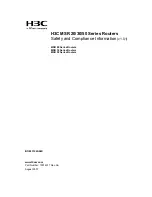
Configuring Wireless Networks
Chapter 10: Working with Wireless Networks
207
In this field…
Do this…
Antenna Selection
Multipath distortion is caused by the reflection of Radio Frequency (RF)
signals traveling from the transmitter to the receiver along more than one
path. Signals that were reflected by some surface reach the receiver after
non-reflected signals and distort them.
IP60 appliances avoid the problems of multipath distortion by using an
antenna diversity system. To provide antenna diversity, each wireless
security appliance has two antennas.
Specify which antenna to use for communicating with wireless stations:
Automatic.
The IP60 appliance receives signals through both
antennas and automatically selects the antenna with the lowest
distortion signal to use for communicating. The selection is
made on a per-station basis. This is the default.
ANT 1.
The ANT 1antenna is always used for communicating.
ANT 2.
The ANT 2 antenna is always used for communicating.
Use manual diversity control (
ANT 1
or
ANT 2
), if there is only one antenna
connected to the appliance.
This field only appears when configuring the primary WLAN, and it is
inherited by all VAPs and WDS links.
Fragmentation
Threshold
Type the smallest IP packet size (in bytes) that requires that the IP packet
be split into smaller fragments.
If you are experiencing significant radio interference, set the threshold to a
low value (around 1000), to reduce error penalty and increase overall
throughput.
Otherwise, set the threshold to a high value (around 2000), to reduce
overhead.
The default value is 2346.
Содержание IP60 - Security Appliance
Страница 1: ...Part No N450000643 Rev 001 Published February 2008 Nokia IP60 Security Appliance User Guide ...
Страница 4: ...4 Nokia IP60 Security Appliance User Guide ...
Страница 10: ......
Страница 12: ......
Страница 38: ......
Страница 58: ......
Страница 108: ......
Страница 268: ......
Страница 482: ......
















































